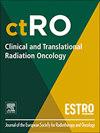Thoracic reirradiation clinical and technical practices: a survey from the reirradiation Collaborative Group (ReCOG)
IF 2.7
3区 医学
Q3 ONCOLOGY
引用次数: 0
Abstract
Introduction
Thoracic reirradiation is increasingly used globally, but prospective evidence is scarce, leading to practice based primarily on institutional experience. Recognizing the need for guidance, international multi-professional experts convened at the first Reirradiation Collaborative Group (ReCOG) Meeting. This report presents results from a survey on best practices, challenges, and knowledge gaps among experts on thoracic reirradiation.
Methods
A comprehensive 50-question survey was developed by experts and discussed within the thoracic focus group at ReCOG. It included questions on participant demographics and clinical experience, patient-related clinical conditions and selection, imaging and targets, treatment planning, and dose accumulation. Participants were asked for perceived challenges as well as gaps in knowledge.
Results
The survey was completed by 34/51 invited experts (67 % response rate). Most respondents (79 %) were experienced physicists and radiation oncologists (>10 years) primarily at university hospitals (65 %). The most common tumors treated were locally recurrent lung cancer, mediastinal nodes, or thoracic metastases. Reirradiation goals included prolonging local control and survival, and alleviating/preventing symptoms. Conditions precluding reirradiation were persistent grade 3+ toxicity and progressive disease. Major toxicity concerns were bleeding, airway injury/fistula, and esophageal ulceration/fistula. Technical practices varied with regards to image registration, dose accumulation and recovery factors. Advanced treatment planning techniques and IGRT were consistent amongst respondents. Major challenges included lack of clinical guidelines and lack of software support tools.
Conclusion
Thoracic reirradiation is an increasingly prevalent area of interest despite scarcity of prospective data. The major focus currently still is primarily on treatment-related factors and the question of how to combine reirradiation with systemic therapy. However, there is little guidance on whether and how to modify a planned reirradiation dose based on patient comorbidities or recovery from the prior radiation course. This survey identified emerging areas of consensus as well as relevant variations and gaps in practice.
胸部再照射临床与技术实践:来自再照射协议组(ReCOG)的调查
胸部再照射在全球范围内的应用越来越广泛,但缺乏前瞻性证据,导致实践主要基于机构经验。认识到需要指导,国际多专业专家召开了第一次再照射协作小组会议。本报告介绍了一项关于胸部再照射专家的最佳实践、挑战和知识差距的调查结果。方法由专家制定了一份包含50个问题的综合调查,并在ReCOG的胸部焦点小组内进行了讨论。它包括参与者的人口统计和临床经验、患者相关的临床状况和选择、成像和靶点、治疗计划和剂量积累等问题。参与者被问及他们认为的挑战以及知识上的差距。结果51名特邀专家中有34人完成调查,回复率67%。大多数应答者(79%)是主要在大学医院工作的经验丰富的物理学家和放射肿瘤学家(10年)(65%)。最常见的肿瘤治疗是局部复发肺癌,纵隔淋巴结,或胸部转移。再照射目标包括延长局部控制和生存,缓解/预防症状。排除再照射的条件是持续的3+级毒性和疾病的进展。主要的毒性问题是出血、气道损伤/瘘管和食管溃疡/瘘管。技术实践在图像配准、剂量累积和恢复系数方面各不相同。先进的治疗计划技术和IGRT在受访者中是一致的。主要的挑战包括缺乏临床指南和缺乏软件支持工具。结论尽管缺乏前瞻性数据,胸部再照射仍是一个日益普遍的研究领域。目前的主要焦点仍然是治疗相关因素以及如何将再照射与全身治疗相结合的问题。然而,关于是否以及如何根据患者的合并症或先前放射过程的恢复情况来修改计划的再照射剂量,几乎没有指导。这项调查确定了正在出现的共识领域以及实践中的相关差异和差距。
本文章由计算机程序翻译,如有差异,请以英文原文为准。
求助全文
约1分钟内获得全文
求助全文
来源期刊

Clinical and Translational Radiation Oncology
Medicine-Radiology, Nuclear Medicine and Imaging
CiteScore
5.30
自引率
3.20%
发文量
114
审稿时长
40 days
 求助内容:
求助内容: 应助结果提醒方式:
应助结果提醒方式:


